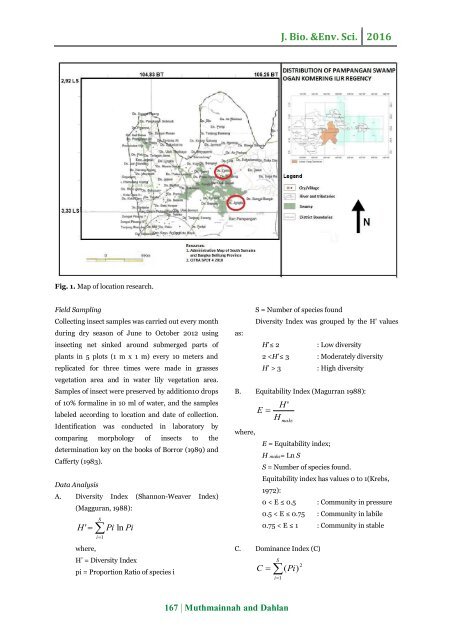Community structure of aquatic insects in pampangan swamp, south sumatra, Indonesia
Abstract Aquatic insects play an important role in the life cycle of fish because they provide feed for young fish. The insect and fisheries have become linked together, and to develop the inland fisheries need some consideration given by insects. Research was conducted in Pampangan Swamp focused on determine the species composition and community structure of aquatic insects in Pampangan swamp, Ogan Komering Ilir Regency, South Sumatra Province. Aquatic insect samples were collected from waters which dominated by grasses and water lily vegetation, using submersible insecting net. Similarity and diversity indices, evenness, and species richness, and important value index were constructed based on field data. The results showed that grass vegetation in Jungkal waters has the highest species richness, 39 individuals/m2 under nine species. Biological indexes such as diversity indexes, evenness indexes and dominance indexes were ranging from 0.24-0.75, 0.35- 0.43, and 0.19- 0.67. Important value index was ranging from 2.44 – 25.46, where the highest value is Belostoma flumineum. The condition of Pampangan swamp is in stable condition with the diversity pattern of aquatic insects which providing the feed for fish.
Abstract
Aquatic insects play an important role in the life cycle of fish because they provide feed for young fish. The insect and fisheries have become linked together, and to develop the inland fisheries need some consideration given by insects. Research was conducted in Pampangan Swamp focused on determine the species composition and community structure of aquatic insects in Pampangan swamp, Ogan Komering Ilir Regency, South Sumatra Province. Aquatic insect samples were collected from waters which dominated by grasses and water lily vegetation, using submersible insecting net. Similarity and diversity indices, evenness, and species richness, and important value index were constructed based on field data. The results showed that grass vegetation in Jungkal waters has the highest species richness, 39 individuals/m2 under nine species. Biological indexes such as diversity indexes, evenness indexes and dominance indexes were ranging from 0.24-0.75, 0.35- 0.43, and 0.19- 0.67. Important value index was ranging from 2.44 – 25.46, where the highest value is Belostoma flumineum. The condition of Pampangan swamp is in stable condition with the diversity pattern of aquatic insects which providing the feed for fish.
You also want an ePaper? Increase the reach of your titles
YUMPU automatically turns print PDFs into web optimized ePapers that Google loves.
J. Bio. &Env. Sci. 2016<br />
Fig. 1. Map <strong>of</strong> location research.<br />
Field Sampl<strong>in</strong>g<br />
Collect<strong>in</strong>g <strong>in</strong>sect samples was carried out every month<br />
dur<strong>in</strong>g dry season <strong>of</strong> June to October 2012 us<strong>in</strong>g<br />
<strong>in</strong>sect<strong>in</strong>g net s<strong>in</strong>ked around submerged parts <strong>of</strong><br />
plants <strong>in</strong> 5 plots (1 m x 1 m) every 10 meters and<br />
replicated for three times were made <strong>in</strong> grasses<br />
vegetation area and <strong>in</strong> water lily vegetation area.<br />
Samples <strong>of</strong> <strong>in</strong>sect were preserved by addition10 drops<br />
<strong>of</strong> 10% formal<strong>in</strong>e <strong>in</strong> 10 ml <strong>of</strong> water, and the samples<br />
labeled accord<strong>in</strong>g to location and date <strong>of</strong> collection.<br />
Identification was conducted <strong>in</strong> laboratory by<br />
compar<strong>in</strong>g morphology <strong>of</strong> <strong><strong>in</strong>sects</strong> to the<br />
determ<strong>in</strong>ation key on the books <strong>of</strong> Borror (1989) and<br />
Cafferty (1983).<br />
Data Analysis<br />
A. Diversity Index (Shannon-Weaver Index)<br />
(Magguran, 1988):<br />
H'<br />
<br />
S<br />
<br />
i1<br />
Pi ln Pi<br />
where,<br />
H’ = Diversity Index<br />
pi = Proportion Ratio <strong>of</strong> species i<br />
S = Number <strong>of</strong> species found<br />
Diversity Index was grouped by the H' values<br />
as:<br />
H’≤ 2<br />
: Low diversity<br />
2 3 : High diversity<br />
B. Equitability Index (Magurran 1988):<br />
E <br />
H '<br />
H maks<br />
where,<br />
E = Equitability <strong>in</strong>dex;<br />
H maks= Ln S<br />
S = Number <strong>of</strong> species found.<br />
Equitability <strong>in</strong>dex has values 0 to 1(Krebs,<br />
1972):<br />
0 < E ≤ 0.5 : <strong>Community</strong> <strong>in</strong> pressure<br />
0.5 < E ≤ 0.75 : <strong>Community</strong> <strong>in</strong> labile<br />
0.75 < E ≤ 1 : <strong>Community</strong> <strong>in</strong> stable<br />
C. Dom<strong>in</strong>ance Index (C)<br />
C <br />
S<br />
<br />
i1<br />
( Pi)<br />
2<br />
167 | Muthma<strong>in</strong>nah and Dahlan


















